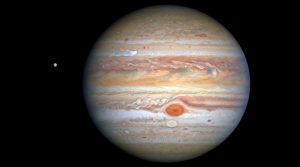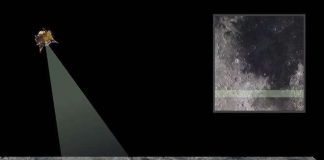SEPTEMBER 19, 2020

NASA’s Hubble telescope is known to capture some of the spectacular occurrences in the space and this time as well, it has captured dazzling images of gigantic Jupiter along with its tiny moon Europa.
The telescopic images that NASA recently released were of the monster planet when it was 406 million miles away from the Earth. The images were snapped on August 25 in ultraviolet, visible new-infrared variety where the planet was reflecting the ultraviolet radiation. These tantalising images depicts beautifully as to how planet Jupiter is draped in blue-hue colour along with alternative patches of bright white and red.
Hubble captured the formation of a tumultuous storm in a particular region of the planet, specifically appearing at a mid-northern latitude in a bright white stretched out composition. The storm seems to be travelling at 350 miles per hour on the surface.
As per the space agency, it is quite common for stormy activities to take place every six years with multiple storms getting generated in the region. These plumes of storms of the gas-made planet throws crucial light upon its billion of years of history pertaining to its composition while it was evolving.
The ultra-violet version of the image captured by the Hubble shows a great red spot on the southern hemisphere of the planet, rotating in an anti-clockwise direction. The depiction of this snapshot portrays a cloud cover over the great red spot with its core and outermost band appearing in dense red colour.
As per the researchers, this red spot is spread across a massive area of 9,800 miles and is colossal enough to swallow the whole Earth. Furthermore, observations concluded by NASA reveals that the clouds at the equator of gigantic planet are vanishing.
Researchers have also noted that the Superstorm ‘Great Red Spot’ is contracting in its surface area on the planet since 1930, but the pace is quite slow. Another similar spot just below it, called Red Spot Jr. was also found in dense red colour in 2006, but since then it is gradually fading, as claimed by the NASA researchers.
Courtesy/Source: Indian Express










































































































